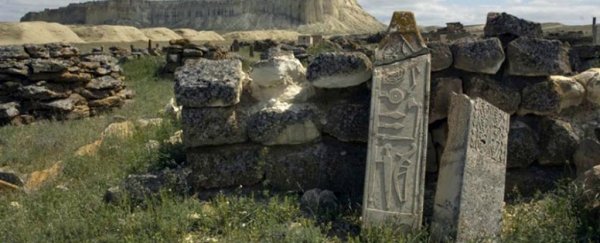Archaeologists have uncovered a gigantic, 1,500-year-old stone monument near the Caspian Sea in Kazakhstan. The structure is reminiscent of Stonehenge, with individual stone slabs sticking out of the ground - but it's on a much grander scale.
The monument coves an area of 300 acres - roughly the equivalent of 200 American football fields - and researchers say it could have been crafted by the Huns.
Each of the stones in the structure are of a different size, with some of the smallest stone slabs measuring 4 metres (13 feet) wide and tall, while others measure up to 34 by 24 metres (112 by 79 feet). At this stage, no one's quite sure why the stones are so varied.
Researchers from the Mangistaus State Historical and Cultural Reserve in Kazakhstan and the Russian Academy of Sciences are still trying to figure out who made this wonderfully huge structure, and so far it's proven quite difficult.
The team's woes started back in 2010, when a man with a metal detector in the region of Altÿnkazgan noticed something strange - bits and pieces of a silver saddle near a massive slab of stone.
It's not unusual for archaeologists to get wind of awesome things hiding underground from amateur treasure hunters, and this find prompted the local man to bring the saddle into the Mangistaus State Historical and Cultural Reserve in Kazakhstan.
"The relief decoration was impressed on the front surface," the team writes of the saddle, which they think could lead to more clues about who owned it, 1,500 years ago. "[S]lver plates would have been laid over the shapes and fixed in place."
But then the team hit a roadblock in their investigation.
"Unfortunately, the socioeconomic situation in the region is not one in which it is easy to engage in archaeological research, and it was not until 2014 that the authors of this article were able to excavate certain features within the site," the team writes.
After finally getting the funds to study the site four years after it was found, the team discovered that the stone structure stretched for much further than they originally thought, and they were able to find more pieces of the silver saddle. But who made them and what was their purpose?
The team isn't sure yet, but they do have some ideas. Based on markings found on the silver saddle, they suggest that the stones were likely constructed by a nomadic tribe around the time that the Roman Empire was falling.
In that area, there was only one real option: the Huns, a nomadic tribe that pillaged and plundered across Eastern Europe and Central Asia for hundreds of years between the first and seventh century AD, though the team says more evidence is needed to make any definitive conclusions.
"The advance of the Huns led various ethnic groups in the Eurasian steppes to move from their previous homelands," the team writes, hinting that the Huns might have forced another group out of the region on their conquests, and these artefacts are leftovers from that migration.
They're also trying to figure out exactly why the stones were created in the first place.
Skeletal remains have been found near one of the stones, but they haven't been dated as yet, meaning they cannot say whether or not the stones could have served as graves. Bur if you think about it, it does seem an awful lot like a cemetery.
It will take further research and excavation for the team to understand the significance of the structure and the nearby saddle, but they hope to have a better idea by 2017. Given the amount of land the structures cover, the region will likely provide new details for many years to come.
The team's work was published in Ancient Civilisations from Scythia to Siberia.
